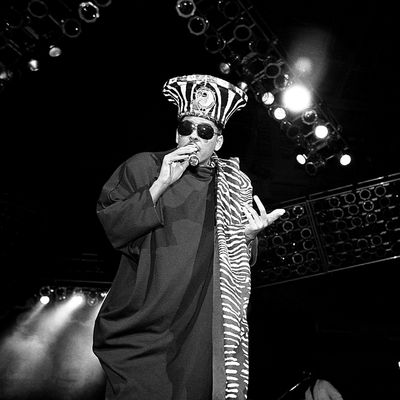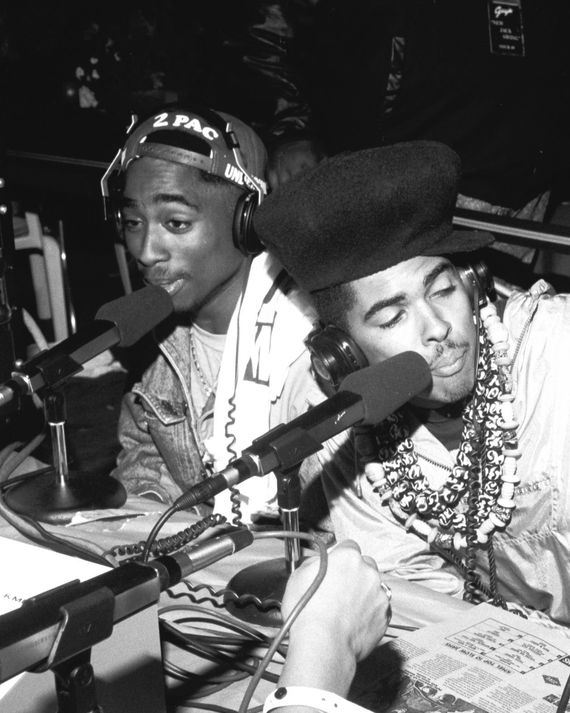
It would be tempting to trace his life’s itinerary and conclude that Shock G’s travels mirror hip-hop’s own trajectory across the continent: born in New York, filtered through Floridian bass, and finally landing in the Bay, where the Panthers and P-funk mixed freely in his brain. But the rapper and producer born Gregory Edward Jacobs in 1963, who died April 22 at the age of 57, did not seem to move so linearly. Instead, his style was pulled down from low-earth orbit and up from the 99-cent bin where he found his signature prop; it was the product of a long, deliberate education, but also forged in alchemic fits of genius that are impossible to teach.
There is a similar urge to look at incidents from an artist’s adolescence and turn them into parables — clean origin stories for the myths that would come later. In Shock G’s case, there’s some truth to that lens. When Jacobs was a teenager in Tampa, Florida, he dropped out of high school to form a DJ crew with his friends. His clique, the Master Blasters, got so hot so quickly that Jacobs was soon made the youngest regular radio DJ in the region. At 16, he had already secured the kind of gig you’d imagine would silence the naysaying adults in his life. Of course, he didn’t keep it, instead getting fired for playing the full, 15-minute version of Funkadelic’s “(Not Just) Knee Deep” in a slot that was only supposed to last for five.
Without a regular gig and with tension in his home life after his parents’ divorce, Jacobs simply left. He traveled the country for a time, backpacking and picking up odd jobs. But his passion for music did not subside; it shapeshifted. He had the notion that he would teach himself the piano — the sort of idea an itinerant young man typically wouldn’t have, at least not until conceding to a permanent address. But Jacobs slipped into the practice rooms at colleges and abused the test-play allowances at music stores until he had the basics down — and then something far beyond the basics.
His course was set: Instead of spinning other people’s records for a living, he’d create his own. Jacobs returned to Florida, where he studied music at a nearby college, began playing shows (either solo piano gigs or rap concerts in early iterations of various groups), and produced other local artists. Around 1985, he moved to Los Angeles. But it was a subsequent move within the couple years, farther up the coast to Oakland, that would see his vision realized. In 1987, Jacobs met a jazz drummer named Jimi Dright, who was trying to cut it as a hip-hop producer, too, under the name Chopmaster J. (This was after Jacobs had made a leap from lurking in music stores to working in one.) Jacobs recommended Dright the gear he coveted for his dream studio, and offered him an unusual deal: he would pull some strings and get it installed for free, on the condition that Dright would allow him to come over and make his own demos.
By this point, Jacobs’s style, musical and otherwise, had undergone a few evolutions. In 2010, he told VIBE that he and his partner “Kenny-K” Waters, both ardent fans of the civil rights leader Kwame Ture, a.k.a Stokely Carmichael, wore berets and hoped to make hip-hop that was heavy, serious, and overtly political. “We were thinking, We are going to have to bomb a courthouse one day,” he cracked. But the pair were discouraged by Public Enemy, who by 1988 had refined their own work to become something of a platonic ideal in that vein of political rap. In hindsight, Jacobs was grateful that Chuck D and the Bomb Squad knocked them off course. It allowed him to found his Oakland-based group, Digital Underground, with the philosophy he adapted from his musical hero, George Clinton: “Free your mind and your ass will follow.”
Any printed roster of Digital Underground is incomplete; dozens of people, including some alter egos of Jacobs’s own creation, cycled in and out over the years. But that doesn’t mean everyone had equal creative input. In addition to Clinton, Jacobs was a Prince fan — who wasn’t? — and admired that the superstar could hole up in a studio alone, playing every instrument by himself and producing records that would normally require the brainpower, not to mention the corporeality, of collaborators. He worked in solitude, or whatever solitude you can claim while using borrowed equipment, to finish a single, “Underwater Rimes,” backed with “Your Life’s a Cartoon.” It came out in ’88 through a small independent label and caught the attention of Tommy Boy, a behemoth rap label — and a New York one at that.
Though he’d lived in New York long enough as a child to become a hip-hop fan, there was to Jacobs a schism between the P-funk he came to love as a Florida teen and the disco that early New York rappers preferred. When hip-hop producers did pull from funk, they leaned too heavily, in Jacobs’s mind, on the James Brown catalogue, or on the “Impeach the President” drums. He was determined to bring the Clinton funk, in sound and spirit, to rap, a mission that was reflected even in the cover art that he often sketched himself — and one that he achieved almost immediately. “Doowutchyalike,” the group’s 1989 single on Tommy Boy, is a near-perfect synthesis of not only the three Clinton songs it samples (and the Prince one, and “Ain’t No Half Steppin,” and “Good Times” …), but of a carefree hedonism and something a little more self-actualized. If only there were a 15-minute version that could get you fired from your day job.
The following year, “Doowutchyalike” appeared alongside a remix of “Underwater Rimes” on Sex Packets, Digital Underground’s 1990 debut album. One of the group’s quasi-members, a singer who would come to the studio straight from his lucrative office gig in a suit and tie, carried in his briefcase what he claimed were plans for government-funded pills that would trigger hyperlucid sex dreams in astronauts. He was “nuts,” as Jacobs laughed it off to VIBE, but when Jacobs’s girlfriend kicked him out of the house and he had to crash on the singer’s couch, he got to playing around with the idea behind those pills. One day, when the singer came home from work, same briefcase in hand, the song was written and the album had its title and concept.
Sex Packets is absurd in a way that makes room for sci-fi funk and supreme raunch — a raunch rendered with glee and a refreshing admiration for the narrators’ sexual partners. It also doesn’t take much squinting to read it with both post-AIDS- and post-crack-crises subtexts; for the album’s backstory, Jacobs decided that if the packets for astronauts were developed in real life, they would inevitably leak onto the streets of San Francisco and be sold as a drug to abuse. He, not Tommy Boy, had flyers printed up speaking to the dangers of this new drug that was supposedly sweeping the city — and, in a sense, it soon would. The record went platinum less than six months after release.
Those sales were driven in large part by the strangest curiosity on an album full of them, Sex Packets’ opening song, “The Humpty Dance.” In it, Jacobs raps in character not as Shock G but one of his alter egos, Humpty Hump, a character codified on the set of the “Doowutchyalike” video, for which he’d purchased a pair of Groucho Marx disguise glasses complete with a comically big nose. Humpty has a goofy voice and goofier clothes and, according to the character’s friends, a signature dance — which is a dance in only the loosest sense — that makes him look like “MC Hammer on crack.”
The song was a massive crossover hit for the group, who went on tour to Europe before it blew up and returned to near-stardom. (“We left as frogs but we came back as princes,” Jacobs would tell VIBE.) Despite the song’s ubiquity, there was plenty of confusion as to whether Humpty was in fact his own person, confusion Jacobs and the group fueled by having him appear as both Humpty Hump and Shock G in various filmed materials, and even by hiring doubles to wear the getup and dance on stage during concerts.
While “The Humpty Dance” is in many ways a novelty song, it works perfectly well on its own merits, to the point of being mesmerizing. It is specific and charmingly lewd, good-natured with the hint of an edge. This is true of songs like “Freaks of the Industry” as well; one of Jacobs’s many gifts was his ability to be extremely funny on record without making a joke of the record. For the clearest evidence of this, consider his most famous protege. In 1990, when Sex Packets was being mixed, the group received a VHS tape of a young, unknown rapper named 2Pac performing a song called “The Case of the Misplaced Mic” alone, in front of his manager’s house, in hopes of impressing them. They welcomed him into the fold immediately, and soon took him on tour as a roadie and backup dancer.
Then, in a moment seared into rap history, Jacobs gave him his big break: a guest verse on 1991’s “Same Song.” In the video, Pac’s dressed as an African king, carried in on a throne by a clot of royal security guards. It is a testament to Pac’s irrepressible talent, of course, but also to Jacobs’s mastery of tone that the younger rapper was able to credibly appear in both that video and “Brenda’s Got a Baby” in the same year. Hijinks like those in “Same Song” would fall out of fashion in mainstream hip-hop for the next several years, but Digital Underground sold them, at the time and in hindsight, by staying a step ahead of those who believed they’d figured out the bit, and by balancing their topical playfulness with constantly expanding musical ambition.
Digital Underground would not maintain those commercial heights, but the tail of Jacobs’s influence is long. It can be seen in his production for other artists, his indelible guest verses, and his discovery of local virtuosos. His presence is also felt in those rappers who skip from one identity to another to get at something deeper in the human condition. This DNA traces to Chicago rapper Serengeti, whose Kenny Dennis character has a similar superficial goofiness as Humpty, but whose life is imagined as full of chronic heartache and a million minor joys. But perhaps the greatest testament to Jacobs’s musical genius is that the real appeal defies the usual qualifiers — a sales pitch would amount to a list of influences, the oddity of his crossover appeal, and, likely, to 2Pac, but those are insufficient metrics. What made his music special was in the cleverness of his syntax, the modulation of his voice, the depth of his grooves. It was as if he came from somewhere else entirely.





